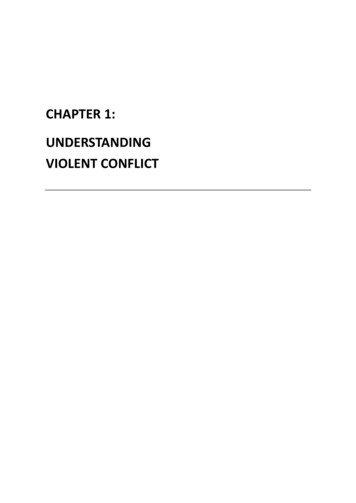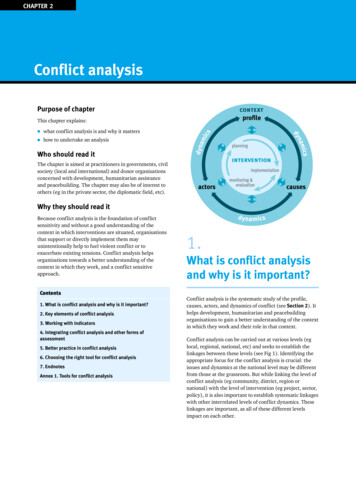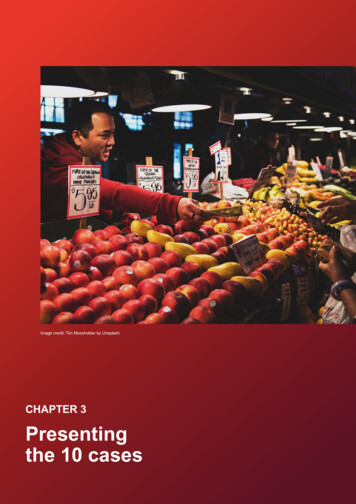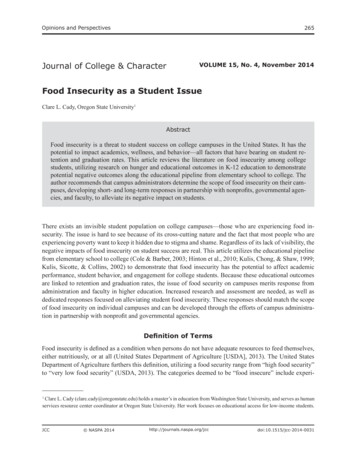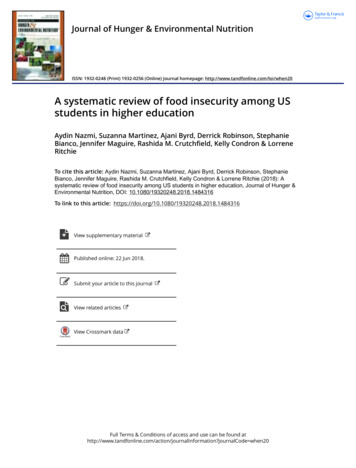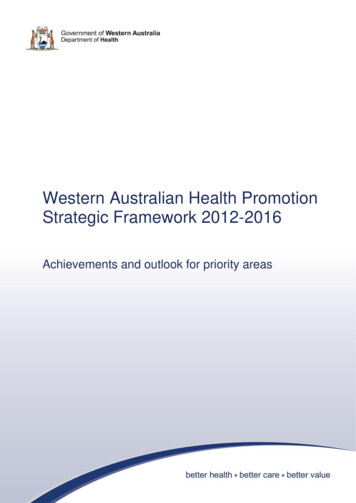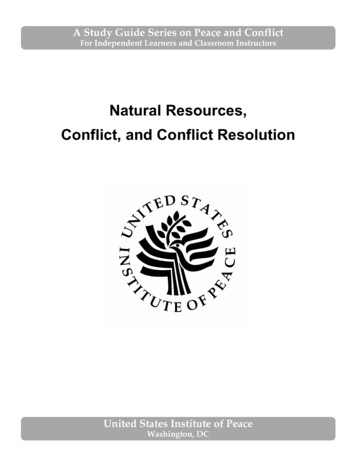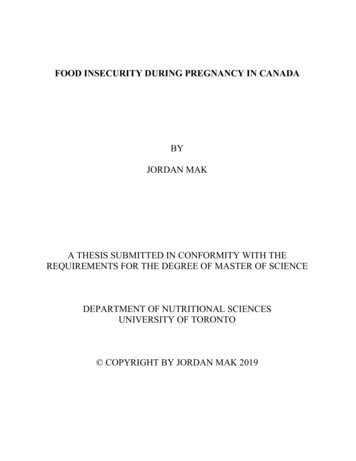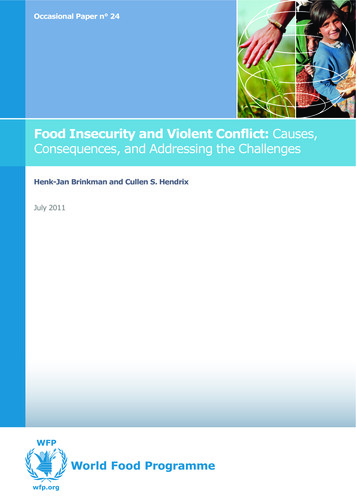
Transcription
Occasional Paper n 24Food Insecurity and Violent Conflict: Causes,Consequences, and Addressing the ChallengesHenk-Jan Brinkman and Cullen S. HendrixJuly 2011
Copyright WFP 2011All Rights Reserved. No part of this publication may be reproduced, stored in a retrieval system ortransmitted, in any form by any means, electronic, mechanical, photocopying or otherwise, without priorpermission of WFP.This document is available online at wfp.org/policy-resourcesThe authors are responsible for the choice and the presentation of the facts contained in this publicationand for the opinions expressed herein, which are not necessarily of, and do not commit, WFP.
Occasional Paper n 24Food Insecurity and Violent Conflict: Causes,Consequences, and Addressing the ChallengesHenk-Jan Brinkman and Cullen S. HendrixJuly 2011
AbstractFood insecurity – especially when caused by a rise infood prices – is a threat and impact multiplier forviolent conflict. It might not be a direct cause andrarely the only cause, but combined with otherfactors, for example in the political or economicspheres, it could be the factor that determineswhether and when violent conflicts will erupt.Changes in food security, rather than levels of foodinsecurity, are probably most influential. Foodinsecurity is neither a necessary nor a sufficientcondition for violent conflict. Food price stabilizationmeasures and safety nets are critical instruments toprevent violent conflict. Food assistance cancontribute to peacebuilding, restore trust ingovernments and rebuild social capital.This paper provides an overview of the link betweenfood insecurity and violent conflict, addressing bothtraditional and emerging threats to security andpolitical stability. It discusses the effects of foodinsecurity on several types of conflict, and thepolitical, social, and demographic factors that mayexacerbate these effects. It then discusses theinterventions that can break the link between foodsecurity and conflict, focusing on mechanisms thatcan shield consumers and producers from food priceshocks. Finally, it discusses ways in which theinternational community can assist in breaking thislink and build peace.Henk-Jan Brinkman is Chief, Policy, Planning and Application in the Peacebuilding Support Office of theUnited Nations. Cullen S. Hendrix is Assistant Professor, The College of William & Mary, and Fellow, RobertS. Strauss Center for International Security and Law, University of Texas at Austin. An earlier version of thispaper was prepared as a background paper for the World Bank’s World Development Report 2011: Conflict,Security and Development. At that time, Henk-Jan was Senior Adviser for Economic Policy at the World FoodProgramme (WFP). The authors wish to thank Jorge Fanlo, Alice Green, Luca Molinas, Joanna Syroka andMiyuki Yamashita for inputs, Farzad Kapadia for excellent research assistance, Vanessa Howe-Jones forediting suggestions and Steven Were Omamo and Lynn Brown and the World Development Report team forconstructive comments. The views expressed in this article do not necessarily represent the official position ofWFP or the United Nations.2
Table of Contents1. Introduction . . . . . . . . . . . . . . . . . . . . . . . . . . . . . . . . . . . . . . . . . . . . . . . . . . . . . . . . . . . .42. Food Insecurity as a Cause of Violence . . . . . . . . . . . . . . . . . . . . . . . . . . . . . . . . . . . . . .5Civil Conflict . . . . . . . . . . . . . . . . . . . . . . . . . . . . . . . . . . . . . . . . . . . . . . . . . . . . . . . . . . . . . . . . . . . . . . . . . . . . . . .5Interstate War . . . . . . . . . . . . . . . . . . . . . . . . . . . . . . . . . . . . . . . . . . . . . . . . . . . . . . . . . . . . . . . . . . . . . . . . . . . . . .6Democratic and Authoritarian Breakdowns . . . . . . . . . . . . . . . . . . . . . . . . . . . . . . . . . . . . . . . . . . . . . . . . . . . .6Protest and Rioting . . . . . . . . . . . . . . . . . . . . . . . . . . . . . . . . . . . . . . . . . . . . . . . . . . . . . . . . . . . . . . . . . . . . . . . . . .7Communal Violence . . . . . . . . . . . . . . . . . . . . . . . . . . . . . . . . . . . . . . . . . . . . . . . . . . . . . . . . . . . . . . . . . . . . . . . . .8Context Matters: Demographic, Social, Political, and Economic Mediators . . . . . . . . . . . . . . . . . . . . . . . . . .83. Food Prices and Fragile States . . . . . . . . . . . . . . . . . . . . . . . . . . . . . . . . . . . . . . . . . . . .11Focus on Fragile States . . . . . . . . . . . . . . . . . . . . . . . . . . . . . . . . . . . . . . . . . . . . . . . . . . . . . . . . . . . . . . . . . . . . . .11Violent Conflict as a Source of Higher Prices . . . . . . . . . . . . . . . . . . . . . . . . . . . . . . . . . . . . . . . . . . . . . . . . . . .124. Breaking the Food Insecurity – Conflict Link . . . . . . . . . . . . . . . . . . . . . . . . . . . . . . . . . . .13Fragile States and Political Capacity . . . . . . . . . . . . . . . . . . . . . . . . . . . . . . . . . . . . . . . . . . . . . . . . . . . . . . . . . .13Policy Interventions in Times of High Prices . . . . . . . . . . . . . . . . . . . . . . . . . . . . . . . . . . . . . . . . . . . . . . . . . . .13Social Protection and Safety Nets: Taking the Longer View . . . . . . . . . . . . . . . . . . . . . . . . . . . . . . . . . . . . . .145. The International Community: Answering the Call, Promoting Peace . . . . . . . . . . . .15Food Assistance and Peacebuilding . . . . . . . . . . . . . . . . . . . . . . . . . . . . . . . . . . . . . . . . . . . . . . . . . . . . . . . . . . .15Food Assistance and Social Capital . . . . . . . . . . . . . . . . . . . . . . . . . . . . . . . . . . . . . . . . . . . . . . . . . . . . . . . . . . .17Transitions from Relief to Recovery . . . . . . . . . . . . . . . . . . . . . . . . . . . . . . . . . . . . . . . . . . . . . . . . . . . . . . . . . . .18Getting Aid Sequencing Right . . . . . . . . . . . . . . . . . . . . . . . . . . . . . . . . . . . . . . . . . . . . . . . . . . . . . . . . . . . . . . . .186. Conclusions . . . . . . . . . . . . . . . . . . . . . . . . . . . . . . . . . . . . . . . . . . . . . . . . . . . . . . . . . . . . . . . . . .20Figure 1. Food Prices and Rioting, 2007-2008 . . . . . . . . . . . . . . . . . . . . . . . . . . . . . . . . . . . . . . . . . . . . . . . . . . .7Table 1. Global factors causing high food prices . . . . . . . . . . . . . . . . . . . . . . . . . . . . . . . . . . . . . . . . . . . . . . . . .11Table 2. Shares of food imports in food consumption and of food in total householdconsumption expenditures . . . . . . . . . . . . . . . . . . . . . . . . . . . . . . . . . . . . . . . . . . . . . . . . . . . . . . . . . . . . . . . . . . .12Box: A comparison of Kenya and the United Republic of Tanzania . . . . . . . . . . . . . . . . . . . . . . . . . . . . . . . . .9Box: Transitioning school feeding in El Salvador . . . . . . . . . . . . . . . . . . . . . . . . . . . . . . . . . . . . . . . . . . . . . . .15Box: School meals as a safety net that contributes to peacebuilding . . . . . . . . . . . . . . . . . . . . . . . . . . . . . . .16Box: Food assistance for conflict-affected populations in Mindanao, the Philippines:Peacebuilding before peace . . . . . . . . . . . . . . . . . . . . . . . . . . . . . . . . . . . . . . . . . . . . . . . . . . . . . . . . . . . . . . . . . .17Box: WFP and IDPs in Côte d’Ivoire: Rebuilding social cohesion . . . . . . . . . . . . . . . . . . . . . . . . . . . . . . . . . .18References . . . . . . . . . . . . . . . . . . . . . . . . . . . . . . . . . . . . . . . . . . . . . . . . . . . . . . . . . . . . . . . .21Annex: Responses of Fragile States to High Food Prices in 2007-08 . . . . . . . . . . . . . . .263
1. IntroductionRising food prices contribute to food insecurity,which is a clear and serious threat to human security.Interest in food security as a catalyst for politicalinstability and conflict has grown rapidly since2007–2008, when food protests and riots broke outin 48 countries as a result of record world prices. InFebruary 2011, the food price index of the Food andAgriculture Organization of the United Nations(FAO) reached a new historic peak, and the rise infood prices contributed to the wave of protests acrossNorth Africa and the Middle East that toppledTunisian president Zine El Abidine Ben Ali andEgyptian president Hosni Mubarak.violence and conflict. Generally, the risk of violentconflict is higher where political regimes intermingledemocratic and authoritarian institutions or when ayouth bulge, low levels of development, deterioratingeconomic conditions, or high inequalities amonggroups are present.Fragile states (which have a high share of foodimports), and the households within them (whomust spend a large share of their income on food),are particularly vulnerable to higher food prices.Moreover, this vulnerability has increased over time.On the other hand, violent conflicts have alsocontributed to higher food prices and foodinsecurity, contributing to a vicious cycle.Among major development organizations, theunchallenged consensus is that war and conflict aredevelopment issues: conflict ravages localeconomies, often leading to forced migration,refugee populations, disease, a collapse of socialtrust, and acute food insecurity. But is foodinsecurity itself a cause of conflict? Based on a reviewof recent research, the answer is a highly qualifiedyes. Food insecurity, especially when caused byhigher food prices, heightens the risk of democraticbreakdown, civil conflict, protest, rioting, andcommunal conflict. The evidence linking foodinsecurity to interstate conflict is less strong, thoughthere is some historical evidence linking decliningagricultural yields to periods of regional conflict inEurope and Asia.While the situation seems bleak, the contingentnature of food insecurity’s effect on conflict suggeststhat governments, international organizations (IOs),and non-governmental organizations (NGOs) cantake positive steps to reduce food insecurity andbreak the relationship between food insecurity andconflict. Governments can act to shield their citizensfrom higher prices and volatility in world markets byinitiating measures to stabilize food prices and byestablishing social protection systems that mitigatethe impact of high food prices on vulnerable groups.Unfortunately, the capacity of fragile states to do thatis limited. The World Food Programme and NGOscan assist in times of acute crisis to provide relief.Finally, governments, IOs and NGOs can work tomake food security a part of the post-conflictpeacebuilding and reconstruction process. Thechallenges are great, but the potential social,economic, and political costs of inaction are evengreater.These links are highly context-specific: they arecontingent on existing political institutions, levels ofeconomic development, social safety nets anddemographic pressures. Food insecurity is neither anecessary nor sufficient condition for acute political4
2. Food Insecurity as a Cause of ViolenceThe traditional security paradigm focuses on militarythreats to sovereign states. The absence of war,however, does not equal peace and stability. Between1990 and 2009, Kenya experienced neither interstatenor intrastate war, yet political and social violence,including election-related rioting, communal conflictand cattle raiding caused over 4,700 deaths(Salehyan et al., 2011). Civil conflict and interstatewar are merely the most obvious manifestations ofpolitical violence; other types of conflict may posesimilarly grave threats to human security.Miguel, 2010). These arguments are most valid withrespect to participation in civil war and rebellion,where participation is better explained by a mixtureof grievances – which provide motivation – andselective incentives – protection from violence andopportunities to engage in predation or to receivefood, clothing, shelter and other material benefits –rather than grievances alone (Berman, 2009). Astudy of demobilized combatants in Sierra Leonefound that poverty, lack of educational access andmaterial rewards were associated with participationin the civil war (Humphreys and Weinstein, 2008).Interestingly, in Liberia, women were more likelythan men to fight for material benefits (Hill et al.,2008). Thus, grievances are important, but so aremotivations related to that individual’s economic andopportunistic considerations.The Roman poet Juvenal recognized in 100 CE thatthe provision of “bread and circuses” was an effectivemechanism for garnering public support andpreventing the populace from expressing discontent.Contemporary observers note that it is not only thelevel of insecurity that matters, but also how thisinsecurity is distributed. Relative deprivation, ratherthan absolute deprivation, generates grievances thatmotivate violent behavior. Thus, many of the studieslinking economic grievances to conflict look at boththe average level of food insecurity and at whetherthat food insecurity is widely experienced orconcentrated in certain groups (Reenock, Bernhardand Sobek, 2007; Østby, 2008).Civil ConflictCivil conflict is the prevalent type of armed conflictin the world today (Harbom and Wallersteen, 2010).It is almost exclusively a phenomenon of countrieswith low levels of economic development and highlevels of food insecurity. Sixty-five percent of theworld’s food-insecure people live in seven countries:India, China, the Democratic Republic of Congo(DRC), Bangladesh, Indonesia, Pakistan andEthiopia (FAO, 2010), of which all but China haveexperienced civil conflict in the past decade, withDRC, Ethiopia, India and Pakistan currentlyembroiled in civil conflicts.Most of the types of political violence addressed hereare more prevalent in societies with higher levels ofchronic food insecurity. There is a correlationbetween food insecurity and political conflict in partbecause both are symptoms of low development(Collier et al., 2003). Nevertheless, a growing body ofresearch makes both direct links and indirect links –as proxied by environmental scarcity or access towater resources – between food scarcity and varioustypes of conflict.Pinstrup-Andersen and Shimokawa (2008) find thatpoor health and nutrition are associated with greaterprobability of civil conflict, though their findings arebased on small sample sizes. Countries with lowerper capita caloric intake are more prone toexperience civil conflict, even accounting for theirlevels of economic development (Sobek andBoehmer, 2009). This relationship is stronger inthose states where primary commodities make up alarge proportion of their export profile. Some of thecountries most plagued by conflict in the past 20years are commodity-rich countries characterized bywidespread hunger, such as Angola, DRC, PapuaNew Guinea and Sierra Leone. The mixture ofhunger – which creates grievances – and theavailability of valuable commodities – which canThe causal arguments linking food insecurity topolitical violence lack microfoundational evidence –evidence based on actions of individuals – to explainhow the mechanism works, but there are plenty oftheories. The theories tend to rest either on theperspective of motivation, emphasizing the effect offood insecurity on economic and social grievances; oron the perspective of the opportunity cost,emphasizing the perceived costs and benefits ofparticipating in violence relative to other means ofsecuring income or food (Gurr, 1970; Tilly, 1978;Humphreys and Weinstein, 2008; Blattman and5
provide opportunities for rebel funding – is a volatilecombination.been challenged (Burke et al., 2009; Buhaug, 2010).Civil war is also more likely in the aftermath ofquick-onset natural disasters, such as earthquakes,major volcanic eruptions, floods, and cyclonic storms(Brancati, 2007; Nel and Righarts, 2008). Therelationship between disaster and conflict isstrongest in countries with high levels of inequalityand slow economic growth; food insecurity andresource scarcity are among the more plausibleexplanations for this correlation.World commodity prices can trigger conflict, ashigher prices, especially for food, increase affectedgroups’ willingness to fight. Timothy Besley andTorsten Persson (2008) find that as a country’simport prices increase, thereby eroding real incomes,the risk of conflict increases. Oeindrila Dube andJuan F. Vargas (2008) arrive at similar conclusionswhen looking at Colombia, where higher exportprices for coffee (which is labour intensive and asource of rural income) reduced violence in coffeeproducing areas while higher export prices for oil(which is capital intensive and a source of income forrebels and paramilitary groups) increased violence inregions with oil reserves and pipelines.Interstate WarThe links between food insecurity and interstate warare less direct. While countries often go to war overterritory, previous research has not focused directlyon access to food or productive agricultural land as amajor driver of conflict (Hensel, 2000). However,wars have been waged to reduce demographicpressures arising from the scarcity of arable land, theclearest examples being the move to acquireLebensraum (“living space”) that motivated NaziGermany’s aggression toward Poland and EasternEurope (Hillgruber, 1981) and Japan’s invasion ofChina and Indochina (Natsios and Doley, 2009).Water, for drinking and for agriculture, is also acause of conflict (Klare, 2002). Countries that shareriver basins are more likely to go to war than areother countries that border one another (Toset et al.,2000; Gleditsch et al., 2006). This relationship isstrongest in countries with low levels of economicdevelopment. Institutions that manage conflicts overwater and monitor and enforce agreements cansignificantly reduce the risk of war (Postel and Wolf,2001).Other research links transitory weather shocks tocivil conflict. In these studies, weather shocks – likedrought and excess rainfall – are thought to fuelconflict by causing crops to fail and reducingagricultural employment opportunities, thusincreasing food insecurity both in terms of foodavailability and food access (ability to pay). Thepeople most likely to participate in armed conflict –young men from rural areas with limited educationand economic prospects – are likely to seek work inthe agricultural sector. As that work dries up,fighting looks more attractive. However, theempirical link between transitory weather shocksand civil conflict is still ambiguous. Some studiesfind that civil conflict is more likely to beginfollowing years of negative growth in rainfall(Miguel, Satyanath and Sergenti, 2004; Hendrix andGlaser, 2007), suggesting that drought anddecreased agricultural productivity expand the poolof potential combatants and give rise to morebroadly held grievances. However, approaches thatlook at levels of rainfall, rather than growth inrainfall from year to year, find tenuous, or in factpositive relationships, between rainfall abundanceand the onset of conflict (Burke et al., 2009; Buhaug,2010; Hendrix and Salehyan, 2010; Ciccone,forthcoming). Some case-based research, however,links drought to conflict – though mediated by thegovernment’s response to the crisis. For example,during the Tuareg rebellion in northern Mali,drought – aggravated by the government’sembezzlement of drought relief supplies and food aid– was a significant source of grievance thatmotivated young men and women to take up arms(Benjaminsen, 2008).Jared Diamond (1997) has argued that for centuriesmilitary power was built on agricultural production.Zhang et al. (2007) show that long-term fluctuationsin the prevalence of war followed cycles oftemperature change over the period 1400–1900 CE,with more war during periods of relatively coolertemperatures and thus lower agriculturalproductivity and greater competition for resources.Similar findings linking cooler periods with morewar have been established for Europe between 1000and 1750 CE (Tol and Wagner, 2008).Democratic and AuthoritarianBreakdownsDemocratic breakdowns occur when leaders aredeposed and replaced by officials who come to powerwithout regard for elections, legal rules, andRecently, warmer temperatures have been linked toan increase in civil conflict, though this finding has6
Europe in 1848 was at least in part a response tofood scarcity, coming after three below-averageharvests across the continent (Berger and Spoerer2001).institutions. Not all breakdowns are violent –“bloodless” coups account for 67 percent of all coupsand coup attempts – but many have been verybloody, and the autocratic regimes and instabilitythat follow democratic breakdowns are more likely tolead to the abuse of human rights, in some casesleading to mass state killing (Poe and Tate, 1994;Harff, 2003).Protest and RiotingThroughout history higher food prices havecontributed to or triggered violent riots. Protests andrioting occurred in response to sharp increases inworld food prices in the 1970s and 1980s (Waltonand Seddon, 1994). Record-high world food pricestriggered protest and violent rioting in 48 countriesin 2007/08 (see Figure 1). The ratio of violent tonon-violent protest was higher in low-incomecountries and in countries with lower governmenteffectiveness (von Braun, 2008). Recent researchlinks higher world food prices for the three mainstaple grains (wheat, rice and maize) to morenumerous protests and riots in developing countries,though this relationship can be mitigated by policyinterventions designed to shield consumers fromhigher prices (Arezki and Brückner, 2011; Bates,2011).Food insecurity, proxied by low availability ofcalories for consumption per capita, makesdemocratic breakdown more likely, especially inhigher-income countries, where people expect thereto be larger social surpluses that could be invested toreduce food insecurity (Reenock, Bernhard andSobek, 2007).Though statistical evidence is lacking, rising foodprices have been implicated in the wave ofdemonstrations and transitions from authoritarianrule to fledgling democracy in some countries acrossNorth Africa and the Middle East in 2011. There aresome historical precedents for this: a bad harvest in1788 led to high food prices in France, which causedrioting and contributed to the French revolution in1789; and the wave of political upheaval that sweptNumber of Food Price RiotsPrice Indices (100 Year 2000 Price)Figure 1. Food Prices and Rioting, 2007-2008FAO Cereals Price IndexFAO Food Price IndexUNCTAD Rice Price IndexFood RiotsSource: Authors, based on WFP data (on riots) and the Food and Agriculture Organization of the UnitedNations (FAO) and the United Nations Conference on Trade and Development (UNCTAD) (price indices)7
International market prices are not the only sourceof food-related protests. The lifting of governmentsubsidies can lead to rioting as well. Until recently,the biggest demonstrations in modern Egyptianhistory were the three-day “bread riots” in 1977 thatkilled over 800 people, which were a response to theEgyptian government’s removal of state subsidies forbasic foodstuffs, as mandated by the InternationalMonetary Fund (IMF) (AFP, 2007). “IMF riots” canbe traced to popular grievances over withdrawn foodand energy subsidies (Walton and Seddon, 1994;Abouharb and Cingranelli, 2007). However, therelationship between “IMF riots” and food insecurityis more complicated. Generalized food and energysubsidies are regressive, meaning that wealthy andmiddle-class households generally capture more ofthe benefits. As such, it may be real income erosion,rather than acute food insecurity, that is drivingparticipation in protest.attacks leads to preemptive attacks – see Posen,1993) and lack of alternative dispute mechanismsbetween groups and effective policing within groups(Fearon and Laitin, 1996).These conflicts have been particularly lethal inKenya, Nigeria, the Sudan and Uganda. Repeatedclashes between Fulani herders and Tarok farmers inNigeria’s Plateau State killed 843 people in 2004.Similar clashes between Rizeigat Abbala and Terjamherders in the Sudan killed 382 in 2007. Cattleraiding in the Karamoja Cluster, a cross-borderregion of Ethiopian, Kenyan and Ugandan territory,resulted in more than 600 deaths and the loss of40,000 heads of livestock in 2004 alone (Meier,Bond and Bond, 2007). These conflicts tend to occurin politically marginalized territories far from thecapital (Raleigh, 2010).Context Matters: Demographic, Social,Political, and Economic MediatorsCommunal ViolenceCompetition over scarce resources, particularly landand water, often causes or exacerbates communalconflict (Homer-Dixon, 1999; Kahl, 2006; Ban,2007). Communal conflict involves groups withpermanent or semi-permanent armed militias butdoes not involve the government. However, it canescalate to include government forces, as in themassacres in Darfur, Rwanda and Burundi. Theseconflicts have the potential to escalate to civil warwhen the government is perceived to be supporting,tacitly or otherwise, one communal group at theexpense of the other (Kahl, 2006). While the conflictin Darfur began as a communal conflict over landand water, its impact escalated to devastatingproportions following the government’s support forJanjaweed militias in their fight against the SudanPeople's Liberation Army/Movement and Justiceand Equality Movement rebels.Food insecurity is a clear contributor to politicalinstability and conflict. But neither hunger norconflict exist in a vacuum: other aspects of thepolitical, economic and social environment affect thedegree to which food insecurity, and grievances moregenerally, are expressed violently (Tilly, 1978).Demographic and Social FactorsIn general, countries with proportionately largernumbers of 15–24 year olds experience more protestand rioting, civil conflict and terrorist attacks (Urdal,2006). Especially in developing countries where jobopportunities are few, many youths engage in blackand grey-market activities or participate in gangs,paramilitary groups and insurgent forces. Kenya’sMungiki, the Kikuyu street gang/paramilitaryorganization based in Nairobi’s Mathare slum, hasattracted many landless, unemployed Kikuyu youths.Mungiki government violence claimed at least 195lives from 2007 to 2009 (Salehyan et al., 2011).Communal conflicts are common in the Sahel, thezone of transition between the Sahara desert and thesavanna, particularly in years of extremely high andlow rainfall (Hendrix and Salehyan, 2010).Recurrent, long-lasting droughts in the Sahel haveundermined cooperative relationships betweenmigratory herders and sedentary farmers, leading tofood insecurity and increased competition for waterand land between farmers and herders, but alsowithin herding and farming groups. As a pastoralistin the Sudan noted: “When there is food, there is nocattle raiding.” (quoted in Schomerus and Allen,2010). Once violence begins, conflict escalates andpersists because of security dilemmas (fear of futureEthnic and religious diversity do not necessarilymake a society more prone to conflict: the UnitedRepublic of Tanzania, one of the world’s mostethnically diverse countries, has been peaceful fordecades (see box on Kenya and the United Republicof Tanzania). However, when ethnic groups aremade the basis for exclusionary patterns of rule, as inSouth Africa under apartheid, conflict is more likely(Langer, 2005; Nafziger et al., 2000; Østby, 2008;Østby, Nordås and Rød, 2009; Cederman,Weidmann and Gleditsch, forthcoming).8
A comparison of Kenya and the United Republic of TanzaniaKenya and the United Republic of Tanzania have much in common. Both are former Britishcolonies that gained independence in the early 1960s, with comparable populations, levelsof economic development and Human Development Index scores. Both are experiencingrapid population growth, have large youth populations and are among the most ethnicallydiverse in the world. Until 2002, hegemonic political parties that faced little oppositiongoverned both countries. Finally, both are characterized by significant food insecurity (theInternational Food Policy Research Institute (IFPRI), 2009; WFP, 2009a).Despite these similarities, conflict is much more prevalent in Kenya. Since independence,Kenya has experienced only one brief episode of civil conflict (an attempted coup in 1982that left 159 people dead). But social conflict has caused over 4,700 reported deathssince 1990 (Salehyan et al., 2011), over 1,700 of which have been associated withcompetition among ethnic groups for land, water and animal resources. In contrast, theUnited Republic of Tanzania has had virtually no internal political violence. Since 1990,political violence has been responsible for only 116 reported deaths, of which only 31 areattributed to communal clashes between farmers and pastoralists.Explanations for this divergence are varied. Economic growth rates have been higher andless variable in the United Republic of Tanzania than in Kenya, and higher rates ofeconomic growth are associated with lower incidences of popular unrest. Kenya also hashigher income inequality. Kenya has made more progress toward democracy, anddemocratization is associated with an increase in political violence and contestation inlower-income countries (Collier and Rohner, 2008). While both countries are ethnicallydiverse, Kenya is composed of fewer, comparatively larger ethnic groups, and these ethnicdivisions are the main basis of political competition. The United Republic of Tanzania ishome to over 120 ethnic groups, but these have not formed the basis for politicaldivisions; national identity is much stronger.The differences may be attributable also to the trajectory of state- and nation-building inthe post-independence period. Under President Julius Nyerere, the government ofTanzania instituted educational and language policies designed to promote a Tanzanianidentity. Moreover
2007-2008, when food protests and riots broke out in 48 countries as a result of record world prices. In February 2011, the food price index of the Food and Agriculture Organization of the United Nations (FAO) reached a new historic peak, and the rise in food prices contributed to the wave of protests across North Africa and the Middle East .
